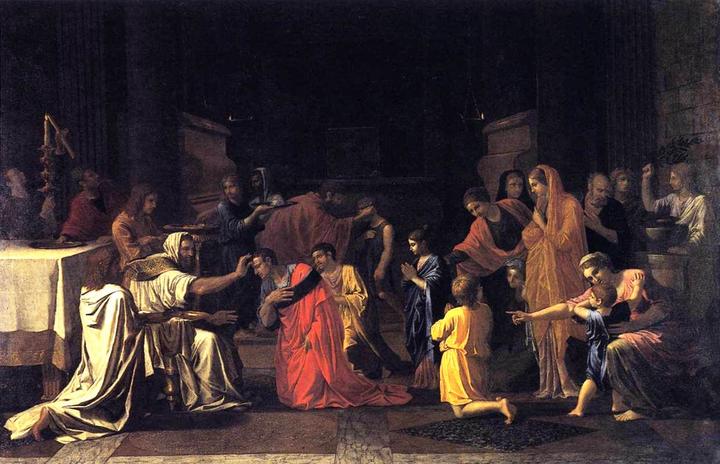Catechesis

Nicholas Poussin, Confirmation (17th century)
From the Catholic Encyclopedia
It has been variously designated: bebaiosis or confirmatio, a making fast or sure; teleiosis or consummatio, a perfecting or completing, as expressing its relation to baptism. With reference to its effect it is the “Sacrament of the Holy Ghost”, the “Sacrament of the Seal” (signaculum, sigillum, sphragis). From the external rite it is known as the “imposition of hands” (epithesis cheiron), or as “anointing with chrism” (unctio, chrismatio, chrisma, myron). The names at present in use are, for the Western Church, confirmatio, and for the Greek, to myron.
In the Western Church the sacrament is usually administered by the bishop. At the beginning of the ceremony there is a general imposition of hands, the bishop meantime praying that the Holy Ghost may come down upon those who have already been regenerated: “send forth upon them thy sevenfold Spirit the Holy Paraclete.” He then anoints the forehead of each with chrism saying: “I sign thee with the sign of the cross and confirm thee with the chrism of salvation, in the name of the Father and of the Son and of the Holy Ghost.” Finally, he gives each a slight blow on the cheek saying: “peace be with thee”. A prayer is added that the Holy Spirit may dwell in the hearts of those who have been confirmed, and the rite closes with the bishop’s blessing…1
From the Catechism of Trent
If ever there was a time that demanded the assiduity of the pastor in explaining the Sacrament of Confirmation, it is doubtless the present, when there are found in the Church of God many by whom it is altogether omitted; whilst very few study to derive from it the fruit of divine grace, which its worthy reception imparts. That this divine blessing, therefore, may not these days seem through their fault, and to the serious injury of their immortal souls, to have been conferred in vain, the faithful are to be instructed, on Whitsunday, and on such other days as the pastor shall deem convenient, in the nature, efficacy, and dignity of this Sacrament; so as to make them sensible that not only is it not to be neglected, but that it is to be approached with the greatest reverence and devotion…2
From the Baltimore Catechism
What is Confirmation?
Confirmation is the sacrament through which the Holy Ghost comes to us in a special way and enables us to profess our faith as strong and perfect Christians and soldiers of Jesus Christ.
But I speak the truth to you; it is expedient for you that I depart. For if I do not go, the Advocate will not come to you. (John 16:7)
Who is the usual minister of Confirmation?
The bishop is the usual minister of Confirmation.
What does the bishop do when he gives Confirmation?
The bishop extends his hands over those who are to be confirmed, prays that they may receive the Holy Ghost, and, while laying his hand on the head of each person, anoints the forehead with holy chrism in the form of a cross. “And when Paul had imposed his hands on them, the Holy Ghost came upon them, and they spoke with tongues and prophesied.” (Acts 19:6)
What does the bishop say in anointing the person he confirms?
In anointing the person he confirms, the bishop says: “I sign you with the sign of the cross and I confirm you with the chrism of salvation, in the name of the Father, and of the Son, and of the Holy Ghost.”
What is holy chrism?
Holy chrism is a mixture of olive oil and balm, blessed by the bishop on Holy Thursday.
What does the anointing of the forehead with chrism in the form of a cross signify?
The anointing of the forehead with chrism in the form of a cross signifies that the Catholic who is confirmed must always be ready to profess his faith openly and to practice it fearlessly.
Why does the bishop give the person he confirms a slight blow on the cheek?
The bishop gives the person he confirms a slight blow on the cheek to remind him that he must be ready to suffer everything, even death, for the sake of Christ.
What are the effects of Confirmation?
Confirmation increases sanctifying grace, gives its special sacramental grace, and imprints a lasting character on the soul. “And when Paul had imposed his hands on them, the Holy Ghost came upon them, and they spoke with tongues and prophesied.” (Acts 19:6)
What does the sacramental grace of Confirmation help us to do?
The sacramental grace of Confirmation helps us to live our faith loyally and to profess it courageously.
What is the character of Confirmation?
The character of Confirmation is a spiritual and indelible sign which marks the Christian as a soldier in the army of Christ.
What is necessary to receive Confirmation properly?
To receive Confirmation properly it is necessary to be in the state of grace, and to know well the chief truths and duties of our religion.
After we have been confirmed, why should we continue to study our religion even more earnestly than before?
After we have been confirmed, we should continue to study our religion even more earnestly than before, so that we may be able to explain and defend our faith, and thus cooperate with the grace of Confirmation.
Why should all Catholics be confirmed?
All Catholics should be confirmed in order to be strengthened against the dangers to salvation and to be prepared better to defend their Catholic faith.
Sources
Scannell, Thomas. “Confirmation.” In The Catholic Encyclopedia. New York: Robert Appleton Company, 1908. https://www.newadvent.org/cathen/04215b.htm. ↩︎
Catholic Church. “Part 2: Confirmation.” Translated by James Donovan. In The Catechism of the Council of Trent, 1829. https://en.wikisource.org/wiki/The_catechism_of_the_Council_of_Trent/Part_2:_Confirmation ↩︎